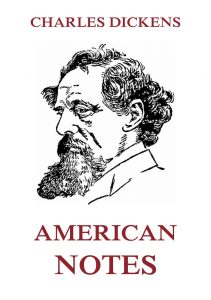American Notes – Charles Dickens
Since the voyage of Columbus in search of the New World, and of Raleigh in quest of El Dorado, no visit to America has excited so much interest and conjecture as that of the author of “Oliver Twist.” . . . In the mean time the book, however disconcerting to those persons who had looked for something quite different, will bring no disappointment to such as can be luxuriously content with good sense, good feeling, good fun, and good writing. The information, with few exceptions, might be gained much more advantageously from the map and gazetteer. The perusal of them has served chiefly to lower our estimate of the man, and to fill us with contempt for such a compound of egotism, coxcombry, and cockneyism. . . . We have never read a book, professing to give an account of any country, which, in respect to its natural features, its towns and cities, its manners and customs, its social, civil, and religious institutions—in short, in respect to everything about which the reader wishes to receive information, or at least to ascertain the opinions of the author, is so profoundly silent as the book before us.

American Notes
American Notes.
ISBN: 9783849676155.
Available at amazon.com and other venues.
Some background on American Notes (from Wikipedia):
On 3 January 1842, one month shy of his 30th birthday, Dickens sailed with his wife, Catherine, and her maid, Anne Brown, from Liverpool on board the steamship RMS Britannia bound for America. Arriving in Boston on 22 January 1842, the author was at once mobbed. Dickens at first revelled in the attention, but soon the endless demands on his time began to wear on his enthusiasm. He complained in a letter to his friend John Forster:
I can do nothing that I want to do, go nowhere where I want to go, and see nothing that I want to see. If I turn into the street, I am followed by a multitude.
He travelled mainly on the East Coast and the Great Lakes area of both the United States and Canada, primarily by steamboat, but also by rail and coach. During his extensive itinerary, he made a particular point of visiting prisons and mental institutions and even took a quick glimpse at the prairie. He was particularly critical of the American press and the sanitary conditions of American cities. He also wrote merciless parodies of the manners of the locals, including, but not limited to, their rural conversations and practice of spitting tobacco in public (Ch. 8 – Washington):
As Washington may be called the headquarters of tobacco-tinctured saliva, the time is come when I must confess, without any disguise, that the prevalence of those two odious practices of chewing and expectorating began about this time to be anything but agreeable, and soon became most offensive and sickening.
In Washington, D.C., he called upon President John Tyler in the White House, writing that:
…he looked somewhat worn and anxious, and well he might; being at war with everybody – but the expression of his face was mild and pleasant, and his manner was remarkably unaffected, gentlemanly, and agreeable. I thought that in his whole carriage and demeanour, he became his station singularly well.
Although generally impressed by what he found, he could not forgive the continued existence of slavery in the United States, and the final chapters of the book are devoted to a criticism of the practice. He was also unhappy about copyright issues. Dickens, by this time, had become an international celebrity, but owing to the lack of an international copyright law, bootleg copies of his works were freely available in North America and he could not abide losing money. Dickens called for international copyright law in many of his speeches in America, and his persistence in discussing the subject led some critics to accuse him of having traveled to America primarily to agitate for that cause.
Dickens’ letters home to his friends, including John Forster and illustrator Daniel Maclise, helped to form the basis of the book.
(The text of the last section was taken from a Wikipedia entry and is available under the Creative Commons Attribution-ShareAlike License.)
Publisher’s Note: This book is printed and distributed by Createspace a DBA of On-Demand Publishing LLC and is typically not available anywhere else than in stores owned and operated by Amazon or Createspace.
